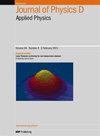Electrical surface breakdown characteristics of micro- and nano-Al2O3 particle co-doped epoxy composites
IF 3.2
3区 物理与天体物理
Q2 PHYSICS, APPLIED
引用次数: 0
Abstract
Epoxy microcomposites are basic materials for gas-insulated switchgear (GIS) spacers that are subjected to huge electrical stress. Previous works have indicated that nanoparticles are beneficial to dielectric performance. However, surface electrical breakdown, a typical fault in GIS of co-doped micro- and nanoparticles in epoxy composites, is seldom studied. In this work, numerous concentrations of micro- and nano-Al2O3 are co-doped into an epoxy matrix; the surface traps, surface charging, and surface breakdown voltages (Vsb) of the co-doped composites are studied, and the influence of micro- and nano-Al2O3 on the electrical surface breakdown is clarified. The results show that Vsb first decreases and then increases with the microparticles, and Vsb decreases from 25.34 kV to 19.52 kV. As the number of nanoparticles increases, Vsb increases and then decreases when the microparticle loading is low, but decreases and then increases when the microparticle loading exceeds 40 wt%. Micro-Al2O3 particles introduce surface shallow traps into epoxy composites, while small amounts of nano-Al2O3 introduce deep traps. Two different mechanisms dominate the surface charging and Vsb of epoxy micro-nanocomposites. When the surface conductivity is lower than 7 × 10−14 S, the surface charges are reduced by the suppression of electrode injection as the trap depth increases, and Vsb increases. When the surface conductivity exceeds 7 × 10−14 S, the surface charge dissipation rate increases with the surface conductivity and Vsb increases as the surface conductivity increases. Our work indicates that co-doped micro- and nano-particles should keep the surface conductivity away from the specic value (7 × 10−14 S) to safeguard insulation properties for GIS spacers.微纳米 Al2O3 粒子共掺环氧树脂复合材料的电表面击穿特性
环氧微复合材料是气体绝缘开关设备(GIS)隔板的基本材料,这些隔板承受着巨大的电应力。以往的研究表明,纳米粒子有利于提高介电性能。然而,对于环氧树脂复合材料中共同掺杂的微纳米粒子在 GIS 中的典型故障--表面电击穿,却很少进行研究。本研究将多种浓度的微纳米 Al2O3 共掺入环氧基体中,研究了共掺复合材料的表面陷阱、表面充电和表面击穿电压(Vsb),并阐明了微纳米 Al2O3 对表面电击穿的影响。结果表明,随着微颗粒的增加,Vsb 先减小后增大,Vsb 从 25.34 kV 减小到 19.52 kV。随着纳米微粒数量的增加,当微粒负载量较低时,Vsb先增大后减小,但当微粒负载量超过 40 wt% 时,Vsb 先减小后增大。微量 Al2O3 颗粒在环氧树脂复合材料中引入了表面浅陷阱,而少量纳米 Al2O3 则引入了深陷阱。环氧微纳米复合材料的表面电荷和 Vsb 由两种不同的机制主导。当表面电导率低于 7 × 10-14 S 时,随着陷阱深度的增加,表面电荷因电极注入的抑制而减少,Vsb 也随之增加。当表面电导率超过 7 × 10-14 S 时,表面电荷耗散率随着表面电导率的增加而增加,Vsb 也随着表面电导率的增加而增加。我们的研究结果表明,共掺杂微纳米粒子应使表面电导率远离特定值(7 × 10-14 S),以保障 GIS 间隔物的绝缘性能。
本文章由计算机程序翻译,如有差异,请以英文原文为准。
求助全文
约1分钟内获得全文
求助全文
来源期刊
CiteScore
6.80
自引率
8.80%
发文量
835
审稿时长
2.1 months
期刊介绍:
This journal is concerned with all aspects of applied physics research, from biophysics, magnetism, plasmas and semiconductors to the structure and properties of matter.

 求助内容:
求助内容: 应助结果提醒方式:
应助结果提醒方式:


